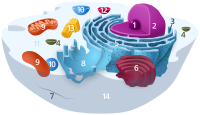
Photo from wikipedia
Membrane contact sites (MCSs) between different organelles have been identified and extensively studied over the last decade. Several classes of MCSs have now well‐established roles, although the contacts between the… Click to show full abstract
Membrane contact sites (MCSs) between different organelles have been identified and extensively studied over the last decade. Several classes of MCSs have now well‐established roles, although the contacts between the endoplasmic reticulum (ER) and the trans‐side of the Golgi network (TGN) have long remained elusive. Until recently, the study of ER–TGN contact sites has represented a major challenge in the field, as a result of the lack of suitable visualization and isolation techniques. Only in the last 5 years has the combination of advanced technologies and innovative approaches permitted the identification of new molecular players and the functions of ER–TGN MCSs that couple lipid metabolism and anterograde transport. Although much has yet to be discovered, it is now established that ER–TGN MCSs control phosphatidyl‐4‐phosphate homeostasis by coupling the cis and the trans activity of the ER‐resident 4‐phosphatase Sac1. In this review, we focus on recent advances on the composition and function of ER–TGN MCSs.
Journal Title: FEBS Letters
Year Published: 2019
Link to full text (if available)
Share on Social Media: Sign Up to like & get
recommendations!